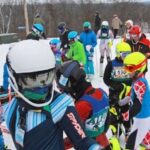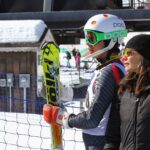I’m sure I’m not the only follower of all things ski racing to observe what appears to be a spate of serious injuries among World Cup stars and up-and-comers. It seems as if, every week, there is more than one article on skiracing.com describing both an inspirational victory by our favorite World Cupper along with a heartbreaking announcement of another World Cupper whose season is shortened or ended by a serious injury. The list I have accumulated from a search on skiracing.com includes (with nationality and body part):
- Wendy Holdener (Switzerland, leg)
- Mauro Caviezel (Switzerland, head)
- Urs Kryenbühl (Switzerland head, clavicle, knee)
- Nicole Schmidhofer (Austria, knee)
- Aleksander Aamodt Kilde (Norway, knee)
- Atle McGrath (Norway, knee)
- Lucas Braathen (Norway, knee)
- Alice McKennis Duran (USA, ankle)
- Jackie Wiles (USA, clavicle)
- Sam DuPratt (USA, both legs)
- Kyle Negomir (USA, hand & knee)
- Tommy Ford (USA, knee)
- Jimmy Krupka (USA, leg)
- Ryan Cochran-Siegle (USA, neck)
- Cameron Alexander (Canada, shoulder)
- Brodie Seger (Canada, knee)
The first thing you’ll notice is that the list is dominated by Americans (potentially due to lack of access to snow during the spring and summer; more on that later). But, aside from that pattern, the first question any rigorous thinker would ask is whether this number is higher than normal. The simple reality is that serious injuries are, sadly, commonplace in our sport. There is no way tell at present whether this outbreak of injuries is a statistical anomaly (meaning it’s due to random variation in injury patterns that occurs over time), a trend that can only be identified with several years of data that may have a specific cause, or, as I and several experts opine, has been caused by the physical and psychological impact of the Covid-19 pandemic on World Cup athletes as an additive factor to the already significant demands placed on their minds and bodies by our sport.
To be sure, this article is based, to some extent, on speculation and conjecture. Yet, it is important to do a deep dive as early as possible when apparent patterns emerge as a means of getting out ahead of the potential causes and looking for solutions for the future. In either case, this exploration can be instructive for athletes, coaches, and sports medicine professionals to more fully understand how to better prepare ski racers for optimal performance and to reduce injuries in the future.
Physical Contributors to Higher Rates of Injury Due to Covid-19
To explore the physical aspects of this year’s pattern of injuries on the World Cup, I’ve reached out to Dr. Greg Rhodes, an exercise physiologist based in Bend, OR, and Dr. Benjamin Costa, a physical therapist based near Truckee, CA, both of whom have extensive experience working with alpine ski racers.
Here’s what Dr. Rhodes had to say:
- Once they got back to training, they may have jumped into conditioning that would be normal for the calendar month they were in, but not where they actually were physically (too much too early).
- Training on their own and not with coach guidance. From social media, seeing Tommy Ford and Laurenne Ross were doing a lot of strength training in their garage gym and not at their normal BOSS Performance Training Center.
- Limited on-snow training during the summer/fall might have led to a decrease in base endurance for these athletes. On-snow camps allow skiers to build ski-specific endurance that is really hard to gain from weight-room and drylands training sessions.
Here’s what Dr. Costa had to say:
- I would say the number-one cause for injuries sustained this ski season is from inadequate year-round training including less total time to train, insufficient proper loading on the muscles, tendons, and bones due to restrictions around training COVID-19 placed upon athletes, coaches, and gyms.
- But let’s venture a guess as to the reason(s) for the recent season-ending injuries to the World Cup ski racers by watching defending World Cup overall champion Aleksander Kilde unfortunate fall during a Super G training run in Austria on January 16th 2021 in which he tore the ACL in his right knee. When reviewing the footage of his unfortunate accident it looks like he experienced a mixture between the “slip catch” and the “dynamic snowplow” mechanisms but the former suspected to be the primary from video review. Both are two of three of the most common mechanisms in which alpine skiers tear their ACL. The “slip catch mechanism” occurs when the skier loses both their balance and edge of the downhill (outside) ski. As that ski attempts to regain snow contact it catches an edge causing internal rotation and valgus rotation which is the kiss of death for the knee of any athlete who participates in cutting sports like skiing. Is the “slip catch mechanism” the result of poor condition or strengthening. In Kilde’s case most undoubtedly not. The reason for his injury could be attributed to so many other factors such as skier technique (Yes, I know he is the defending World Cup champion but skier technique at the world cup level is the most frequent reason that puts skiers in dangerous positions where ACL tears are most likely to occur), equipment considerations, snow conditions, and course conditions. The truth is the reason cannot be simplified or reduced. Instead, a complex and dynamic system produces injuries. As Kilde said in an interview after the accident “it’s impossible to say what the reason is” for his season ending injury.
Psychological Contributors to Higher Rates of Injury Due to Covid-19
As for what mental and emotional factors may have contributed to the injuries on the World Cup, I have a few ideas:
- Very few people fully appreciate the toll that Covid-19 has taken on all of us physically and psychologically. Over the past ten months, the pandemic has put us in a low-grade and persistent state of stress, creating in us uncertainty, hyper vigilance, anxiety, worry, and doubt. When you add in the high levels of investment that World Cup ski racers have in our sport (it is both their passion and profession!) and the uncertainty it has presented to them, the volume on these stressors has been turned up even more.
- This uncertainty in both training opportunities and the possibility of having no race season reduced the motivation to train early in Covid-19 (I heard this consistently from the World Cup athletes I work with). This ambiguity for the future could also have caused racers to soften their goals and let up just a bit on their drive and determination, all of which would result in a lower level of fitness entering the winter season.
- The reduced preparation, both in terms of conditioning and on-snow training, would naturally hurt confidence in how ready the racers were for the World Cup season. In turn, this lowered confidence could also reduce, even slightly, the commitment that World Cupper make to their turns, placing them in a less stable position on their skis and, as a result, make them more susceptible to injury.
- The ongoing stress caused by the pandemic created anxiety and bodily tension which could have created feelings of physical discomfort (“I just haven’t felt quite right since Covid-19 struck,” said one World Cupper to me) and muscle bracing (a natural evolutionary response to stress that worked on the Serengeti 250,000 years ago to help our ancestors survive but increases injury risk among ski racers in 2021).
- Focus has been another victim of Covid-19. When under stress, our focus tends to either narrow excessively (don’t look ahead on course) or become distracted (with interfering thoughts or feelings, or irrelevant outside cues). The pandemic has certainly caused us to have to shift our focus constantly to the myriad daily news, threats, guidelines, orders, and worries that were ever-present in and often overwhelming our attentional field. It has also pulled our focus away other important parts of our lives, in the case of World Cuppers, less attention on being prepared. Clearly, attention directed toward Covid-19 has meant less focus on preparation. Plus, as we can all see, less focus while training and racing means World Cuppers would be at greater risk of injury.
- One thing that we have all experienced during the pandemic has been more negative emotions more often than usual. For all of us, frustration, anger, disappointment, sadness, depression, and even periodic feelings of despair are normal and expected, yet problematic, reactions to Covid-19. These unhealthy emotions could be impacting all of the other mental areas I just described as well as altering many aspects of World Cuppers’ physiology, all to their detriment and all putting them at increased risk of injury.
- Another less noticeable effect of Covid-19 has been an increase in isolation and loneliness. When it comes to ski racing, it takes a village to support, train, and prepare athletes for the World Cup. The pandemic caused racers to have to separate themselves from family, friends, teammates, coaches, trainers, and other members of their team. This detachment alone can create many of the physical and psychological experiences that can lead to a higher vulnerability to injury.
- One last point that Dr. Rhodes suggested was that, with Covid-19 setting back their training and preparation, and the Beijing Olympics coming next season (hopefully!), World Cuppers may have been concerned about qualifying for their respective Olympic teams. As a result, they may have been feeling the need to push their limits a bit further than normal and a bit too far for their bodies to be able to support given the already extreme demands of ski racing (particularly in the speed events where most injuries occur) and the already stunted preparation caused by Covid-19. This boundary pushing, combined with all of the unhealthy physical and psychological changes that may have been caused by the pandemic that I’ve described above, could have placed World Cuppers’ bodies in situations that they simply weren’t capable of handling safely.
My thanks to Drs. Rhodes and Costa for sharing their expertise in this article. Though I focused on the impact of Covid-19 on its effect on World Cup racers, I believe that the ideas I have shared can be of great benefit to racers, coaches, and programs at all levels of our sport. The issues I explored are relevant to potentially reducing injury among younger racers as well. They may also prove helpful to everyone in the ski racing community to be more aware of and react appropriately to the many physical and psychological challenges that Covid-19 has confronted us with.
Want to make mental training a part of your winter training and race plan? Here are a few options:
- Read my Ski Racing blogs.
- Read my latest mental training book: Train Your Mind for Athletic Success.
- Sign up for one of my online mental training courses for racers, coaches, or parents.
- Work with me 1:1.





